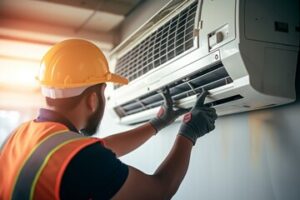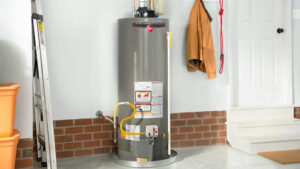An AC repair warranty can be a great way to save money on costly repairs. However, it’s essential to understand how the process works before using one.

If your air conditioning unit frequently cycles on and off, it may be due to dirty filters. Changing the filter should fix this problem. Visit Website to learn more.
The thermostat is one of the most important parts of an air conditioning system, but it can also be prone to malfunction. This is not surprising, as thermostats are complex pieces of technology with many moving parts.
The good news is that most thermostat problems are easy to identify and resolve. First, check the batteries in your thermostat and replace them if necessary. If the problem persists, it may be a wiring issue. Make sure the wires are not twisted, corroded or disconnected from the thermostat. Loose wires can prevent the thermostat from receiving power, causing it to malfunction.
Another common thermostat issue is when the temperature reading doesn’t match the conditions in your home. This can be caused by direct sunlight, proximity to hot lamps or cold drafts. In these cases, relocating the thermostat may help fix the problem.
If the thermostat is still unresponsive, it may be time to call a professional. A faulty thermostat can cause your AC to short cycle, which means it will turn on and off repeatedly, rather than maintaining a consistent temperature. This can place a lot of stress on the compressor and lead to early failure.
Over time, even the best thermostats will wear out. The average lifespan of a thermostat is about 10-15 years. If yours is approaching this age, it’s a good idea to consider upgrading it. Newer thermostats can offer a range of advanced features, making them more convenient for homeowners.
Finally, if you haven’t done so already, clean the thermostat. This can be done by removing the cover and wiping it down with a damp cloth. It’s also a good idea to examine the inside of your thermostat for loose or corroded wiring.
Faulty Compressor
The compressor is the heart of your AC system. It takes a cool refrigerant chemical and squeezes it until it’s under very high pressure. This high-pressure gas is then run through your cooling system to remove heat and excess humidity from the indoor air. If the compressor fails to perform correctly, it could affect your entire home’s comfort and even lead to further damage to other components in your AC unit.
One of the first signs that the compressor is beginning to fail are rattling noises. This symptom is often caused by electrical problems inside the compressor and is a good indicator that you should call a professional right away.
Another sign that the compressor is beginning to go bad is if it is difficult to start. This is often a result of an electrical problem within the unit, but if you leave it alone it could cause further damage to your compressor and ultimately lead to a much more expensive repair bill.
A compressor that is having trouble starting may also make a chattering or ticking sound when it’s turned on. This is a common issue that can be easily fixed by a professional. The chattering and ticking noises are often the result of a relay switch that is broken or worn out. If you catch this problem in time, replacing the relay switch can help save your compressor and prevent it from failing.
Many of the issues that lead to AC compressor failure can be avoided with regular maintenance. This is especially true if you choose to work with an AC company that has MSCA or NATE-certified technicians. They will be able to ensure that your AC system is properly serviced and will not have problems with the compressor that can lead to premature breakdown.
In addition to routine maintenance, it’s a good idea to install a voltage stabilizer and have a professional inspect your electrical wiring on a regular basis. This will reduce the chance of AC compressor failure and other electrical problems that can lead to costly repairs.
Refrigerant Leaks
Refrigerant is the secret sauce that allows your air conditioner to absorb heat from the air and exchange it for cool, refreshing air. Because of this, refrigerant leaks are an enormous problem for your system and should not be ignored. Leaks can happen due to erosion of metal components, wear and tear, and even age-related issues. If your AC unit has a refrigerant leak, it will lead to a higher energy bill, inefficient cooling, and may even pose health risks from inhalation of the fumes.
Refrigerants are toxic and should not be handled by anyone other than a licensed HVAC professional. A small amount of refrigerant leaking into the environment will not harm you, but significant amounts of the chemical can release harmful gases. These fumes can irritate your respiratory system and cause you to feel dizzy or lightheaded, and could even result in long-term health effects. If you think that your cooling system is leaking refrigerant, it is best to contact an expert right away for a quick fix.
One of the most common signs of a refrigerant leak is a hissing sound from your unit. This hissing noise is created by cracks or holes in the parts of your evaporator coil that distribute refrigerant. As the hissing continues, it will allow more and more of your refrigerant to escape and leave your evaporator coil empty.
Leaks can also occur from corrosion of the copper lines that transport the refrigerant. This happens when air comes into contact with the chemicals in refrigerant and creates acid that corrodes the pipes. The corrosion is most likely to occur in places where the copper lines are thinner, such as in the outdoor unit or in the linesets that connect your evaporator coils and condenser.
The only way to confirm a refrigerant leak is to drain your system and then fill it with nitrogen, which will create a bubble if there is a hole in the copper lines. This process is usually done by an experienced technician who can then locate the leak and repair it.
Warm Air from Vents
Sometimes, your AC may be blowing warm air even though it’s working properly. This could mean that something is going on in your ductwork that you can’t see. If your ducts have holes, cracks, or are disconnected, return air might be escaping into rooms without making it back to the unit. This makes your system work harder, leading to a lower cooling output and the air coming out of the vents being warmer.
Another common problem is that a room’s furniture might be blocking one or more of your vents. Make sure that all the vents are clear and open. If a vent is blocked by a couch, bed, dresser, or other large object, the cool air can’t escape and it will instead just circulate around your house. This leads to overworking your system and it will eventually stop working altogether.
You should also check that the drain line is not clogged. The AC drain removes any moisture that it produces while running, but if it becomes clogged, it won’t be able to get the excess water out of the system and it will continue to build up, causing the system to overheat and then shut down. If the clog is severe, it’s important to call in an HVAC specialist as soon as possible.
It’s also possible that your evaporator coil is frozen. This is another issue that should be addressed by an experienced technician to avoid permanent damage to the unit and costly replacement costs.
